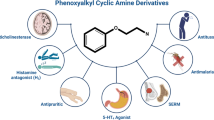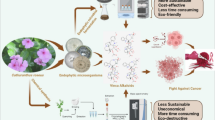Abstract
We have strategically designed a series of noscapine derivatives by inserting biaryl pharmacophore (a major structural constituent of many of the microtubule-targeting natural anticancer compounds) onto the scaffold structure of noscapine. Molecular interaction of these derivatives with α,β-tubulin heterodimer was investigated by molecular docking, molecular dynamics simulation, and binding free energy calculation. The predictive binding affinity indicates that the newly designed noscapinoids bind to tubulin with a greater affinity. The predictive binding free energy (ΔGbind, pred) of these derivatives (ranging from −5.568 to −5.970 kcal/mol) based on linear interaction energy (LIE) method with a surface generalized Born (SGB) continuum solvation model showed improved binding affinity with tubulin compared to the lead compound, natural α-noscapine (−5.505 kcal/mol). Guided by the computational findings, these new biaryl type α-noscapine congeners were synthesized from 9-bromo-α-noscapine using optimized Suzuki reaction conditions for further experimental evaluation. The derivatives showed improved inhibition of the proliferation of human breast cancer cells (MCF-7), human cervical cancer cells (HeLa) and human lung adenocarcinoma cells (A549), compared to natural noscapine. The cell cycle analysis in MCF-7 further revealed that these compounds alter the cell cycle profile and cause mitotic arrest at G2/M phase more strongly than noscapine. Tubulin binding assay revealed higher binding affinity to tubulin, as suggested by dissociation constant (Kd) of 126 ± 5.0 µM for 5a, 107 ± 5.0 µM for 5c, 70 ± 4.0 µM for 5d, and 68 ± 6.0 µM for 5e compared to noscapine (Kd of 152 ± 1.0 µM). In fact, the experimentally determined value of ΔGbind, expt (calculated from the Kd value) are consistent with the predicted value of ΔGbind, pred calculated based on LIE–SGB. Based on these results, one of the derivative 5e of this series was used for further toxicological evaluation. Treatment of mice with a daily dose of 300 mg/kg and a single dose of 600 mg/kg indicates that the compound does not induce detectable pathological abnormalities in normal tissues. Also there were no significant differences in hematological parameters between the treated and untreated groups. Hence, the newly designed noscapinoid, 5e is an orally bioavailable, safe and effective anticancer agent with a potential for the treatment of cancer and might be a candidate for clinical evaluation.
















Similar content being viewed by others
References
Mitchison TJ, Kirschner M (1984) Dynamic instability of microtubule growth. Nature 312:237–242
Kirschner M, Mitchison TJ (1986) Beyond self-assembly: from microtubules to morphogenesis. Cell 45:329–342
Van Tellingen O, Sips JH, Beijnen JH, Bult A, Nooijen WJ (1992) Pharmacology, bio-analysis and pharmacokinetics of the vinca alkaloids and semi-synthetic derivatives. Anticancer Res 12:1699–1715
Rowinsky EK (1997) The development and clinical utility of the taxane class of antimicrotubule chemotherapy agents. Annu Rev Med 48:353–374
Crown J, O’Leary M (2000) The taxanes: an update. Lancet 355:1176–1178
Goncalves A, Braguer D, Kamath K, Martello L, Briand C, Horwitz S, Wilson L, Jordan MA (2001) Resistance to taxol in lung cancer cells associated with increased microtubule dynamics. Proc Natl Acad Sci USA 98:11737–11741
Ye K, Ke Y, Keshava N, Shanks J, Kapp JA, Tekmal RR, Petros J, Joshi HC (1998) Opium alkaloid noscapine is an antitumor agent that arrests metaphase and induces apoptosis in dividing cells. Proc Natl Acad Sci USA 95:1601–1606
Ye K, Zhou J, Landen JW, Bradbury EM, Joshi HC (2001) Sustained activation of p34 (cdc2) is required for noscapine-induced apoptosis. J Biol Chem 276:46697–46700
Zhou J, Panda D, Landen JW, Wilson L, Joshi HC (2002) Minor alteration of microtubule dynamics causes loss of tension across kinetochore pairs and activates the spindle checkpoint. J Biol Chem 277:17200–17208
Zhou J, Gupta K, Yao J, Ye K, Panda D, Giannakakou P, Joshi HC (2002) Paclitaxel-resistant human ovarian cancer cells undergo c-Jun NH2-terminal kinase-mediated apoptosis in response to noscapine. J Biol Chem 277:39777–39785
Ke Y, Ye K, Grossniklaus HE, Archer DR, Joshi HC, Kapp JA (2000) Noscapine inhibits tumor growth with little toxicity to normal tissues or inhibition of immune responses. Cancer Immunol Immunother 49:217–225
Landen JW, Lang R, McMahon SJ, Rusan NM, Yvon AM, Adams AW, Sorcinelli MD, Campbell R, Bonaccorsi P, Ansel JC, Archer DR, Wadsworth P, Armstrong CA, Joshi HC (2002) Noscapine alters microtubule dynamics in living cells and inhibits the progression of melanoma. Cancer Res 62:4109–4114
Landen JW, Hau V, Wang MS, Davis T, Ciliax B, Wainer BH, Van Meir EG, Glass JD, Joshi HC, Archer DR (2004) Noscapine crosses the blood-brain barrier and inhibits glioblastoma growth. Clin Cancer Res 10:5187–5201
Dahlstrom B, Mellstrand T, Lofdahl C, Johansson M (1982) Pharmacokinetic properties of noscapine. Eur J Clin Pharmacol 22:535–539
Segal MS, Goldstein MM, Attinger EO (1957) The use of noscapine (narcotine) as an antitussive agent. Dis Chest 32:305–309
Loder RE (1969) Safe reduction of the cough reflex with noscapine: a preliminary communication on a new use for an old drug. Anaesthesia 24:355–358
Santoshi S, Naik PK, Joshi HC (2011) Rational design of novel anti-microtubule agent (9-azido-Noscapine) from quantitative structure activity relationship (QSAR) evaluation of noscapinoids. J Biomol Screen 16:1047–1058
Naik PK, Chatterji BP, Vangapandu SN, Aneja R, Chandra R, Kanteveri S, Joshi HC (2011) Rational design, synthesis and biological evaluations of amino-noscapine: a high affinity tubulin-binding noscapinoid. J Comput Aided Mol Des 25:443–454
Naik PK, Lopus M, Aneja R, Vangapandu SN, Joshi HC (2012) In silico inspired design and synthesis of a novel tubulin-binding anti-cancer drug: folate conjugated noscapine (Targetin). J Comput Aided Mol Des 26:233–247
Manchukonda NK, Naik PK, Santoshi S, Lopus M, Joseph S, Sridhar B, Kantevari S (2013) Rational design, synthesis and biological evaluation of third generation α-noscapine analogues as potent tubulin binding anti-cancer agents. PLoS One 8(10):e77970
Jain N, Yada D, Shaik TB, Vasantha G, Reddy PS, Kalivendi SV, Sreedhar B (2011) Synthesis and antitumor evaluation of nitrovinyl biaryls: anticancer agents based on allocolchicines. Chem Med Chem 6(5):859–868
Marzaro G, Coluccia A, Ferrarese A, Brun P, Castagliuolo I, Conconi MT, Regina GL, Bai R, Silvestri R, Hamel E, Chilin A (2014) J Med Chem 57:4598–4605
Lee C, Yang W, Parr RG (1988) Development of the Colle-Salvetti correlation-energy formula into a functional of the electron density. Phys Rev B 37:785–789
Becke AD (1993) A new mixing of Hartree–Fock and local density-functional theories. J Chem Phys 98:1372–1377
Gordon MS, Binkley JS, Pople JA, Pietro WJ, Hehre WJ (1982) Self-consistent molecular-orbital methods. 22. Small split-valence basis sets for second-row elements. J Am Chem Soc 104:2797–2803
Berendsen HJC, van der Spoel D, van Drunen R (1995) GROMACS: a message passing parallel molecular dynamics implementation. Comput Phys Commun 91:43–56
Laskowski RA, Moss DS, MacArthur MW, Thornton JM (1993) PROCHECK: a program to check the stereochemical quality of protein structures. J Appl Crystal 26:283–291
Colovos C, Yeates TO (1993) Verification of protein structures: patterns of non-bonded atomic interactions. Protein Sci 2:1511–1519
Eisenberg D, Luthy R, Bowie JU (1997) VERIFY3D: assessment 694 of protein models with three-dimensional profiles. Methods Enzymol 277:396–404
Ramachandran GN, Ramakrishnan C, Sasisekharan V (1963) Stereochemistry of polypeptide chain configurations. J Mol Biol 7:95–99
Naik PK, Santoshi S, Rai A, Joshi HC (2011) Molecular modelling and competition binding study of Br-noscapine and colchicine provide insight into noscapinoid-tubulin binding site. J Mol Graph Model 29:947–955
Friesner RA, Banks JL, Murphy RB, Halgren TA, Klicic JJ, Mainz DT, Repasky MP, Knoll EH, Shelley M, Perry JK, Shaw DE, Francis P, Shenkin PS (2004) Glide: a new approach for rapid, accurate docking and scoring. 1. Method and assessment of docking accuracy. J Med Chem 47:1739–1749
Halgren TA, Murphy RB, Friesner RA, Beard HS, Frye LL, Pollard WT, Banks JL (2004) Glide: a new approach for rapid, accurate docking and scoring. 2. Enrichment factors in database screening. J Med Chem 47:1750–1759
Case DA, Darden TA, Cheatham TE, Simmerling CL, Wang J, Duke RE, Luo R, Walker RC, Zhang W, Merz KM, Roberts B, Wang B, Hayik S, Roitberg A, Seabra G, Kolossváry I, Wong KF, Paesani F, Vanicek J, Liu J, Wu X, Brozell SR, Steinbrecher T, Gohlke H, Cai Q, Ye X, Wang J, Hsieh MJ, Cui G, Roe DR, Mathews DH, Seetin MG, Sagui C, Babin V, Luchko T, Gusarov S, Kovalenko A, Kollman PA (2010) AMBER 11. University of California, San Francisco
Cornell WD, Cieplak P, Bayly CI, Gould IR, Merz KM Jr, Ferguson DM, Spellmeyer DC, Fox T, Caldwell JW, Kollman PA (1995) A second generation force field for the simulation of proteins, nucleic acids, and organic molecules. J Am Chem Soc 117:5179–5197
Ryckaert JP, Ciccotti G, Berendsen HJC (1977) Numerical integration of the Cartesian equations of motion of a system with constraints: molecular dynamics of n-alkanes. J Comput Phys 23:327–341
Daren T, York D, Pedersen L (1993) Particle mesh Ewald: an N-log(N) method for Ewald sums in large systems. J Chem Phys 98:10089–10092
Hornak V, Abel R, Okur A, Strockbine B, Roitberg A, Simmerling C (2006) Comparison of multiple Amber force fields and development of improved protein backbone parameters. Protein 65:712–725
Berendsen HJC, Postma JPM, Van Gunsteren WF, DiNola A, Haak JR (1984) Molecular dynamics with coupling to an external bath. J Chem Phys 81:3684–3691
Srinivasan J, Cheatham TE, Cieplak P, Kollman PA, David A (1998) Case continuum solvent studies of the stability of DNA, RNA, and phosphoramidate-DNA helicesm. J Am Chem Soc 120:9401–9409
Kollman PA, Massova I, Reyes C, Kuhn B, Huo S, Chong L, Lee M, Lee T, Duan Y, Wang W, Donini O, Cieplak P, Srinivasan J, Case DA, Cheatham TE (2000) Calculating structures and free energies of complex molecules: combining molecular mechanics and continuum models. Acc Chem Res 33:889–897
Zhou R, Frienser RA, Ghosh A, Rizzo RC, Jorgensen WL, Levy RM (2001) New linear interaction method for binding affinity calculations using a continuum solvent model. J Phys Chem B 105:10388–10397
Aneja R, Vangapandu SN, Lopus M, Viswesarappa VG, Dhiman N, Verma A, Chandra R, Panda D, Joshi HC (2006) Synthesis of microtubule-interfering halogenated noscapine analogues that perturb mitosis in cancer cells followed by cell death. Biochem Pharmacol 72:415–426
Aneja R, Vangapandu SN, Lopus M, Chandra R, Panda D, Joshi HC (2006) Development of a novel nitro-derivative of noscapine for the potential treatment of drug-resistant ovarian cancer and Tcell lymphoma. Mol Pharmacol 69:1801–1809
Bruker (2001) SAINT (version 6.28a) and SMART (version 5.625). Bruker AXS Inc., Madison, Wisconsin
Sheldrick GM (2008) A short history of SHELX. Acta Crystallogr A64:112–122
Flack HD, Bernardinelli G (2000) Reporting and evaluating absolute-structure and absolute-configuration determinations. J Appl Crystallogr 33:1143–1148
Hamel E, Lin CM (1981) Glutamate-induced polymerization of tubulin: characteristics of the reaction and application to the large-scale purification of tubulin. Arch Biochem Biophys 209:29–40
Panda D, Chakrabarti G, Hudson J, Pigg K, Miller HP, Wilson L, Himes RH (2000) Suppression of microtubule dynamic instability and treadmilling by deuterium oxide. Biochemistry 39:5075–5081
Bradford MM (1976) A rapid and sensitive method for the quantitation of microgram quantities of protein utilizing the principle of protein/dye binding. Anal Biochem 72:248–254
Zhou J, Gupta K, Aggarwal S, Aneja R, Chandra R, Panda D, Joshi HC (2003) Brominated derivatives of noscapine are potent microtubule-interfering agents that perturb mitosis and inhibit cell proliferation. Mol Pharmacol 63:799–807
Aneja R, Dhiman N, Idnani J, Awasthi A, Arora SK, Chandra R, Joshi HC (2007) Preclinical pharmacokinetics and bioavailability of noscapine, a tubulin-binding anticancer agent. Cancer Chemother Pharmacol 60:831–839
Acknowledgments
We are thankful to Jaypee University of Information Technology, India, for providing student’s fellowship to Seneha Santoshi. We thank Mr. Birendra Patel, Professor in English, for proof reading the manuscript. We are greatly indebted to the anonymous reviewers of this manuscript for their helpful suggestions.
Author information
Authors and Affiliations
Corresponding author
Rights and permissions
About this article
Cite this article
Santoshi, S., Manchukonda, N.K., Suri, C. et al. Rational design of biaryl pharmacophore inserted noscapine derivatives as potent tubulin binding anticancer agents. J Comput Aided Mol Des 29, 249–270 (2015). https://doi.org/10.1007/s10822-014-9820-5
Received:
Accepted:
Published:
Issue Date:
DOI: https://doi.org/10.1007/s10822-014-9820-5




